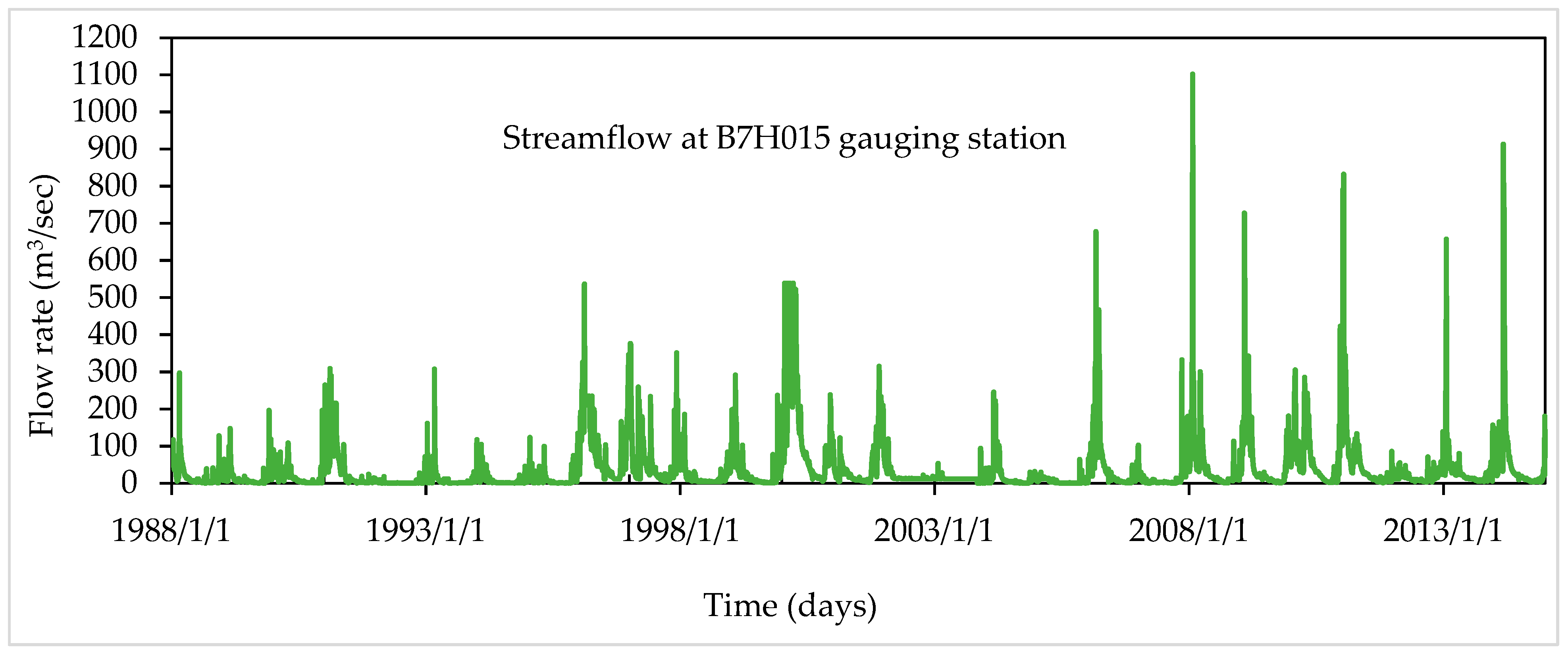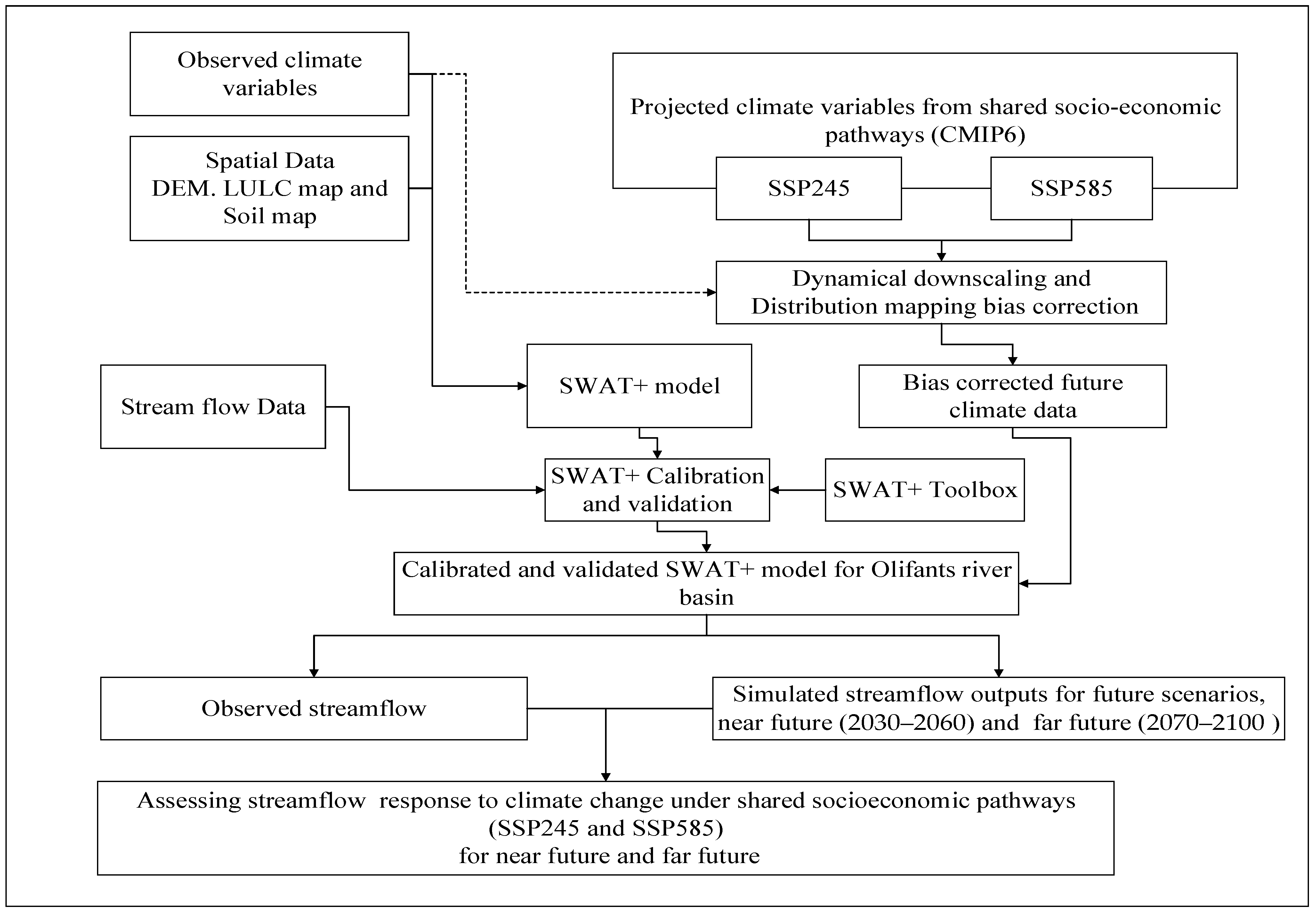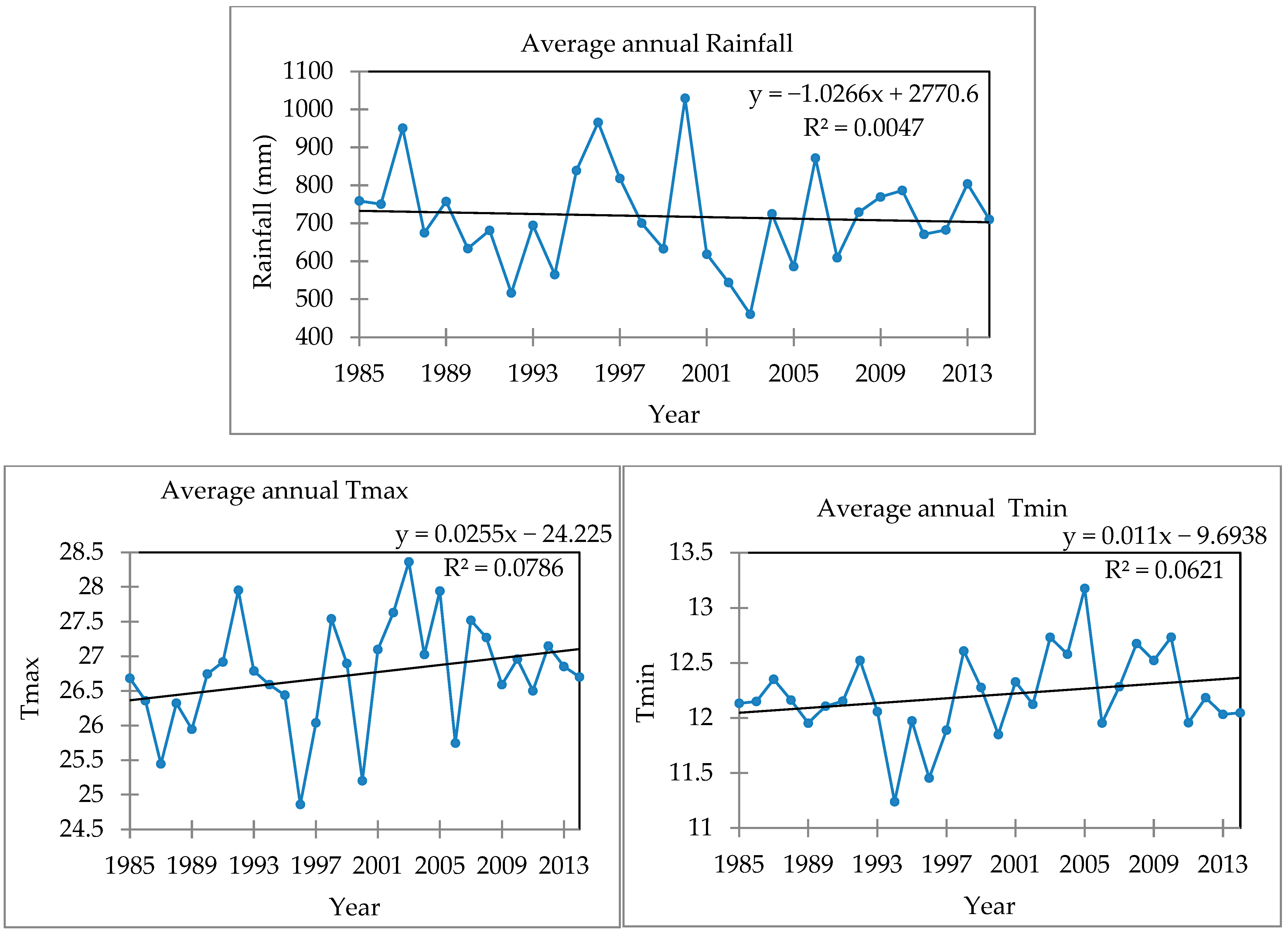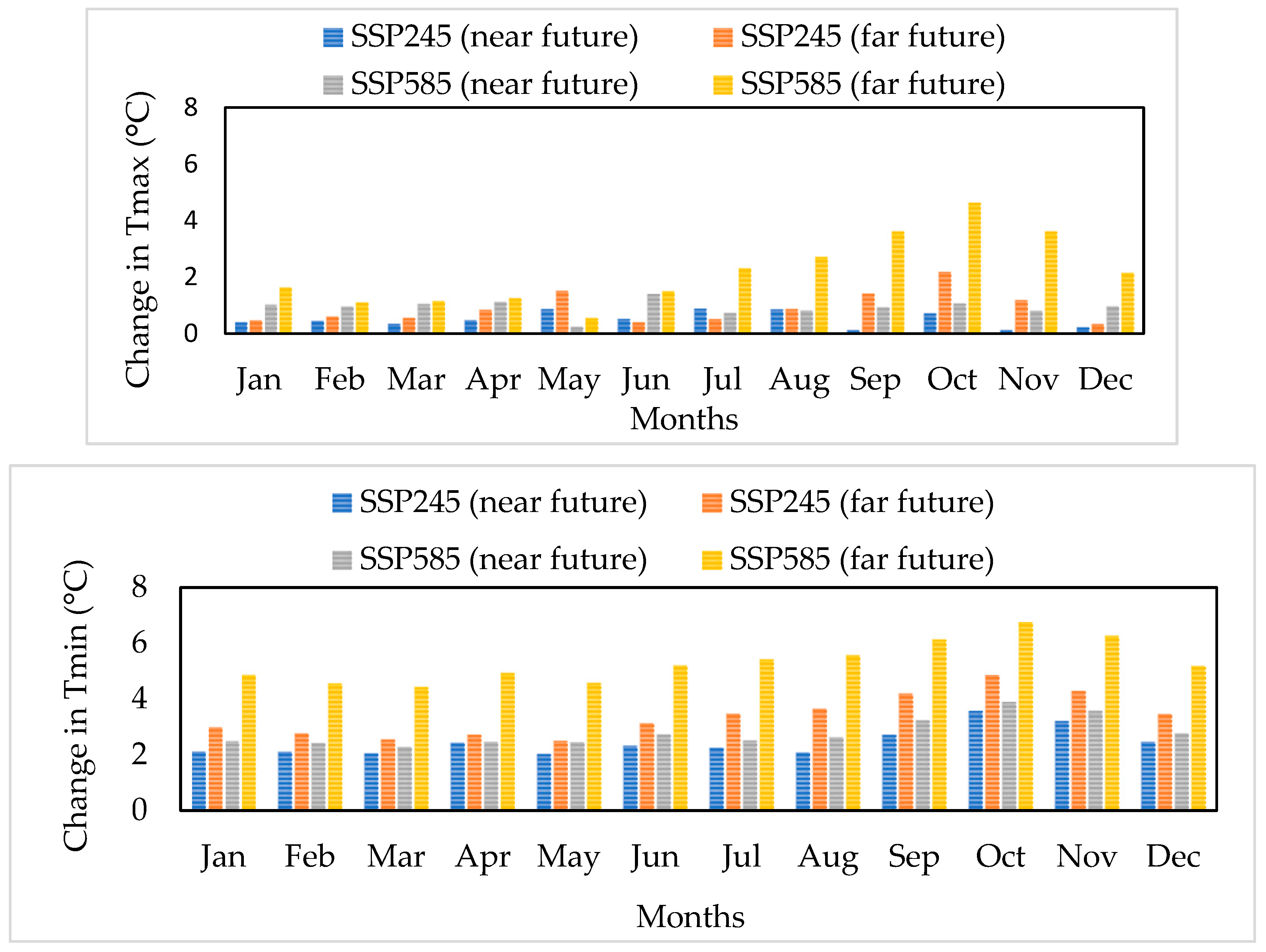Assessing Streamflow Response to Climate Change Under Shared Socioeconomic Pathways (SSPs) in the Olifants River Basin, South Africa
Abstract
1. Introduction
2. Materials and Methods
2.1. Description of the Study Area
2.2. Datasets and Method
2.2.1. Details of Input Data and Sources
2.2.2. Methodological Framework
2.3. Bias Correction and Downscaling Method
2.4. Multi-Model Ensemble Mean (MME)
2.5. Trend Analysis
2.6. Hydrological Modeling
2.6.1. Model Sensitivity Analysis, Calibration, and Validation
2.6.2. Model Performance Evaluation
3. Results
3.1. Performance of the Hydrological Model
3.2. Rainfall and Temperature Trend Analysis
3.3. Projected Changes in Climatic Variables
3.3.1. Monthly Precipitation
3.3.2. Monthly Temperature
3.3.3. Annual Changes in Precipitation and Temperatures
3.4. Streamflow Response to Climate Change
4. Discussion
5. Conclusions
Supplementary Materials
Author Contributions
Funding
Data Availability Statement
Acknowledgments
Conflicts of Interest
References
- Wang, X.; Liu, L. The Impacts of Climate Change on the Hydrological Cycle and Water Resource Management. Water 2023, 15, 2342. [Google Scholar] [CrossRef]
- Ehtasham, L.; Sherani, S.H.; Nawaz, F. Acceleration of the hydrological cycle and its impact on water availability over land: An adverse effect of climate change. Meteorol. Hydrol. Water Manag. 2024, 12, 1–21. [Google Scholar] [CrossRef]
- Kgabi, N.A.; Amwele, H.R. Ensuring Sustainability of Groundwater Resources: A Review of Challenges and Initiatives by Southern African Arid and Semi-arid Countries. In Water Management in Developing Countries and Sustainable Development; Springer: Singapore, 2024. [Google Scholar] [CrossRef]
- Thakur, R. The Impacts of Climate Change on Water Resources in the Anthropocene: Mitigation and Adaptation Strategies in Southern Africa. In Climate Change and Socio-Political Violence in Sub-Saharan Africa in the Anthropocene; Springer: Cham, Switzerland, 2024. [Google Scholar] [CrossRef]
- Kusangaya, S.; Mazvimavi, D.; Shekede, M.D.; Masunga, B.; Kunedzimwe, F.; Manatsa, D. Climate Change Impact on Hydrological Regimes and Extreme Events in Southern Africa. In Climate change and water resources in Africa; Springer: Cham, Switzerland, 2021; pp. 87–129. [Google Scholar] [CrossRef]
- Park, S.Y.; Moon, H.T.; Kim, J.S.; Lee, J.H. Assessing the Impact of Human-Induced and Climate Change-Driven Streamflow Alterations on Freshwater Ecosystems. Ecohydrol. Hydrobiol. 2024, 25, 1–9. [Google Scholar] [CrossRef]
- Reshma, C.; Arunkumar, R. Assessment of impact of climate change on the streamflow of Idamalayar River Basin, Kerala. J. Water Clim. Chang. 2023, 14, 2133–2149. [Google Scholar] [CrossRef]
- Kassaye, S.M.; Tadesse, T.; Tegegne, G.; Hordofa, A.T.; Malede, D.A. Relative and Combined Impacts of Climate and Land Use/Cover Change for the Streamflow Variability in the Baro River Basin (BRB). Earth 2024, 5, 149–168. [Google Scholar] [CrossRef]
- Kusangaya, S.; Warburton, M.L.; Archer van Garderen, E.; Jewitt, G.P.W. Impacts of climate change on water resources in southern Africa: A review. Phys. Chem. Earth 2014, 67, 47–54. [Google Scholar] [CrossRef]
- Nkhonjera, G.K.; Dinka, M.O.; Woyessa, Y.E. Assessment of localized seasonal precipitation variability in the upper middle catchment of the olifants river basin. J. Water Clim. Chang. 2021, 12, 250–264. [Google Scholar] [CrossRef]
- Adeola, A.M.; Kruger, A.; Makgoale, T.E.; Botai, J.O. Observed trends and projections of temperature and precipitation in the Olifants River Catchment in South Africa. PLoS ONE 2022, 17, e0271974. [Google Scholar] [CrossRef]
- Olabanji, M.F.; Ndarana, T.; Davis, N.; Archer, E. Climate change impact on water availability in the olifants catchment (South Africa) with potential adaptation strategies. Phys. Chem. Earth 2020, 120, 102939. [Google Scholar] [CrossRef]
- Udall, B. 21st Century Climate Change Impacts on Olifants River Flows. 2018, pp. 1–38. Available online: https://cer.org.za/wp-content/uploads/2019/08/Annexure-I-Udall-Report.pdf (accessed on 22 July 2024).
- Gyamfi, C.; Ndambuki, J.M.; Salim, R.W. Hydrological responses to land use/cover changes in the Olifants Basin, South Africa. Water 2016, 8, 588. [Google Scholar] [CrossRef]
- Ershadfath, F.; Shahnazari, A.; Sarjaz, M.R.; Andaryani, S.; Trolle, D.; Olesen, J.E. Blue and green water availability under climate change in arid and semi-arid regions. Ecol. Inform. 2024, 82, 102743. [Google Scholar] [CrossRef]
- Durack, P.J.; Taylor, K.E.; Gleckler, P.J.; Meehl, G.A.; Lawrence, B.N.; Covey, C.; Stouffer, R.J.; Levavasseur, G.; Ben-nasser, A.; Denvil, S.; et al. The Coupled Model Intercomparison Project (CMIP): Reviewing project history, evolution, infrastructure and implementation. EGUsphere, 2025; 2025, 1–74. [Google Scholar] [CrossRef]
- Ma, D.; Bai, Z.; Xu, Y.P.; Gu, H.; Gao, C. Assessing streamflow and sediment responses to future climate change over the Upper Mekong River Basin: A comparison between CMIP5 and CMIP6 models. J. Hydrol. Reg. Stud. 2024, 52, 101685. [Google Scholar] [CrossRef]
- Eyring, V.; Cox, P.M.; Flato, G.M.; Gleckler, P.J.; Abramowitz, G.; Caldwell, P.; Collins, W.D.; Gier, B.K.; Hall, A.D.; Hoffman, F.M.; et al. Taking climate model evaluation to the next level. Nat. Clim. Chang. 2019, 9, 102–110. [Google Scholar] [CrossRef]
- Qin, D.; Ding, Y.; Zhai, P.; Song, L.; Luo, Y.; Jiang, K. The Change of Climate and Ecological Environment in China 2021: Synthesis Report; Springer Nature: Dordrecht, The Netherlands, 2023. [Google Scholar] [CrossRef]
- Chandra, N.A.; Sahoo, S.N. Assessing the impacts of climate and land cover change on groundwater recharge in a semi-arid region of Southern India. Theor. Appl. Climatol. 2024, 155, 7147–7163. [Google Scholar] [CrossRef]
- Janjić, J.; Tadić, L. Fields of Application of SWAT Hydrological Model—A Review. Earth 2023, 4, 331–344. [Google Scholar] [CrossRef]
- Pulighe, G.; Lupia, F.; Chen, H.; Yin, H. Modeling climate change impacts on water balance of a mediterranean watershed using swat+. Hydrology 2021, 8, 157. [Google Scholar] [CrossRef]
- Bieger, K.; Arnold, J.G.; Rathjens, H.; White, M.J.; Bosch, D.D.; Allen, P.M.; Volk, M.; Srinivasan, R. Introduction to SWAT+, A Completely Restructured Version of the Soil and Water Assessment Tool. J. Am. Water Resour. Assoc. 2017, 53, 115–130. [Google Scholar] [CrossRef]
- Bieger, K.; Arnold, J.G.; Rathjens, H.; White, M.J.; Bosch, D.D.; Allen, P.M. Representing the Connectivity of Upland Areas to Floodplains and Streams in SWAT+. J. Am. Water Resour. Assoc. 2019, 55, 578–590. [Google Scholar] [CrossRef]
- Barresi, O.L.; Sauvage, S.; Houska, T.; Bieger, K.; Schürz, C.; Sánchez Pérez, J.M. Representation of Hydrological Components under a Changing Climate—A Case Study of the Uruguay River Basin Using the New Version of the Soil and Water Assessment Tool Model (SWAT+). Water 2023, 15, 2604. [Google Scholar] [CrossRef]
- Gurusinghe, T.; Mut, L.; Matheswaran, K.; Dickens, C. Developing a Foundational Hydrological Model for the Limpopo River Basin Using the Soil and Water Assessment Tool Plus (SWAT+); CGIAR Initiative on Digital Innovation; International Water Management Institute (IWMI): Colombo, Sri Lanka, 2024; pp. 1–14. Available online: https://hdl.handle.net/10568/151939 (accessed on 22 July 2024).
- Wagner, P.D.; Bieger, K.; Arnold, J.G.; Fohrer, N. Representation of hydrological processes in a rural lowland catchment in Northern Germany using SWAT and SWAT+. Hydrol. Process. 2022, 36, 14589. [Google Scholar] [CrossRef]
- Nkhonjera, G.K. Understanding the impact of climate change on the dwindling water resources of South Africa, focusing mainly on Olifants River basin: A review. Environ. Sci. Policy 2017, 71, 19–29. [Google Scholar] [CrossRef]
- Mthethwa, N.P. Hydrological Impacts of Sustainable Land Management in the Olifants Sub-Basin. Master’s Thesis, University of the Witwatersrand, Johannesburg, South Africa, 2021; pp. 43–49. [Google Scholar]
- Liu, W.; Wu, J.; Xu, F.; Mu, D.; Zhang, P. Modeling the effects of land use/land cover changes on river runoff using SWAT models: A case study of the Danjiang River source area, China. Environ. Res. 2024, 242, 117810. [Google Scholar] [CrossRef] [PubMed]
- Gebisa, B.T.; Dibaba, W.T. Ensemble modeling of the hydrological impacts of climate change: A case study of the Baro River sub-basin, Ethiopia. Hydrol. Res. 2024, 55, 1143–1160. [Google Scholar] [CrossRef]
- O’Neill, B.C.; Tebaldi, C.; Van Vuuren, D.P.; Eyring, V.; Friedlingstein, P.; Hurtt, G.; Knutti, R.; Kriegler, E.; Lamarque, J.F.; Lowe, J.; et al. The Scenario Model Intercomparison Project (ScenarioMIP) for CMIP6. Geosci. Model Dev. 2016, 9, 3461–3482. [Google Scholar] [CrossRef]
- Masimba, O.; Gumindoga, W.; Mhizha, A.; Rwasoka, D.T. Impacts of climate change on streamflow and reservoir inflows in the Upper Manyame sub-catchment of Zimbabwe. Water SA 2022, 48, 359–368. [Google Scholar] [CrossRef]
- Sajjan, P.; Krupavathi, K.; Aparna, C. Projection of future climate data using global circulation models. In Futuristic Trends in Agriculture Engineering & Food Science; Iterative International Publishers (IIP): Chikmagalur, Karnataka, India, 2024; Volume 3, pp. 113–126. [Google Scholar]
- Rathjens, H.; Bieger, K.; Srinivasan, R.; Arnold, J.G. CMhyd User Manual Documentation for Preparing Simulated Climate Change Data for Hydrologic Impact Studies; SWAT: Garland, TX, USA, 2016; pp. 1–16. [Google Scholar]
- Yeboah, K.A.; Akpoti, K.; Kabo-bah, A.T.; Ofosu, E.A.; Siabi, E.K.; Mortey, E.M.; Okyereh, S.A. Assessing climate change projections in the Volta Basin using the CORDEX-Africa climate simulations and statistical bias-correction. Environ. Chall. 2022, 6, 100439. [Google Scholar] [CrossRef]
- Fang, G.H.; Yang, J.; Chen, Y.N.; Zammit, C. Comparing bias correction methods in downscaling meteorological variables for a hydrologic impact study in an arid area in China. Hydrol. Earth Syst. Sci. 2015, 19, 2547–2559. [Google Scholar] [CrossRef]
- Teutschbein, C.; Seibert, J. Bias correction of regional climate model simulations for hydrological climate-change impact studies: Review and evaluation of different methods. J. Hydrol. 2012, 456, 12–29. [Google Scholar] [CrossRef]
- Lazoglou, G.; Economou, T.; Anagnostopoulou, C.; Zittis, G.; Tzyrkalli, A.; Georgiades, P.; Lelieveld, J. Multivariate adjustment of drizzle bias using machine learning in European climate projections. Geosci. Model Dev. 2024, 17, 4689–4703. [Google Scholar] [CrossRef]
- Min, S.K.; Hense, A. A Bayesian approach to climate model evaluation and multi-model averaging with an application to global mean surface temperatures from IPCC AR4 coupled climate models. Geophys. Res. Lett. 2006, 33, L08708. [Google Scholar] [CrossRef]
- Weigel, A.P.; Knutti, R.; Liniger, M.A.; Appenzeller, C. Risks of model weighting in multimodel climate projections. J. Clim. 2010, 23, 4175–4191. [Google Scholar] [CrossRef]
- Miao, C.; Duan, Q.; Yang, L.; Borthwick, A.G.L. On the Applicability of Temperature and Precipitation Data from CMIP3 for China. PLoS ONE 2012, 7, 0044659. [Google Scholar] [CrossRef] [PubMed]
- Buontempo, C.; Mathison, C.; Jones, R.; Williams, K.; Wang, C.; McSweeney, C. An ensemble climate projection for Africa. Clim. Dyn. 2015, 44, 2097–2118. [Google Scholar] [CrossRef]
- Kim, J.; Ivanov, V.Y.; Fatichi, S. Climate change and uncertainty assessment over a hydroclimatic transect of Michigan. Stoch. Environ. Res. Risk Assess. 2016, 30, 923–944. [Google Scholar] [CrossRef]
- You, Q.; Jiang, Z.; Wang, D.; Pepin, N.; Kang, S. Simulation of temperature extremes in the Tibetan Plateau from CMIP5 models and comparison with gridded observations. Clim. Dyn. 2018, 51, 355–369. [Google Scholar] [CrossRef]
- Ahmed, K.; Sachindra, D.A.; Shahid, S.; Demirel, M.C.; Chung, E.S. Selection of multi-model ensemble of general circulation models for the simulation of precipitation and maximum and minimum temperature based on spatial assessment metrics. Hydrol. Earth Syst. Sci. 2019, 23, 4803–4824. [Google Scholar] [CrossRef]
- Manjurul, H. and I.M. pyMannKendall: A python package for non parametric Mann Kendall family of trend tests. J. Open Source Softw. 2019, 4, 1556. [Google Scholar] [CrossRef]
- Gyamfi, C.; Ndambuki, J.M.; Salim, R.W. A Historical Analysis of Rainfall Trend in the Olifants Basin in South Africa. Earth Sci. Res. 2016, 5, 129. [Google Scholar] [CrossRef]
- Dile, Y.T.; Daggupati, P.; George, C.; Srinivasan, R.; Arnold, J. Introducing a new open source GIS user interface for the SWAT model. Environ. Model. Softw. 2016, 85, 129–138. [Google Scholar] [CrossRef]
- Kakarndee, I.; Kositsakulchai, E. Comparison between SWAT and SWAT+ for simulating streamflow in a paddy-field-dominated basin, northeast Thailand. E3S Web Conf. 2020, 187, 06002. [Google Scholar] [CrossRef]
- Chawanda; Arnold, J.; Thiery, W.; van Griensven, A. Mass balance calibration and reservoir representations for large-scale hydrological impact studies using SWAT+. Clim. Change 2020, 163, 1307–1327. [Google Scholar] [CrossRef]
- Merlo, A. Runoff Modelling Using QSWAT+ to Assess the Contribution of Piped Network Stormflow in the Haaganpuro Semi-Urban Catchment. Master’s Thesis, Politecnico di Torino, Torino, Italy, 2023; p. 87316161. [Google Scholar]
- Aryal, S.; Babel, M.S.; Gupta, A.; Farjad, B.; Khadka, D.; Hassan, Q.K. Attribution of the Climate and Land Use Change Impact on the Hydrological Processes of Athabasca River Basin, Canada. Hydrology 2025, 12, 7. [Google Scholar] [CrossRef]
- Chawanda, C. Hydrological Modelling Using SWAT+ Training Manual (v1). 2021. Available online: https://www.qgis.org/en/site/forusers/download.html (accessed on 22 July 2024).
- Abbas, S.A.; Bailey, R.T.; White, J.T.; Arnold, J.G.; White, M.J.; Čerkasova, N.; Gao, J. A framework for parameter estimation, sensitivity analysis, and uncertainty analysis for holistic hydrologic modeling using SWAT+. Hydrol. Earth Syst. Sci. 2024, 28, 21–48. [Google Scholar] [CrossRef]
- Sane, M.L.; Sambou, S.; Leye, I.; Ndione, D.M.; Diatta, S.; Ndiaye, I.; Badji, M.L.; Kane, S. Calibration and Validation of the SWAT Model on the Watershed of Bafing River, Main Upstream Tributary of Senegal River: Checking for the Influence of the Period of Study. Open, J. Mod. Hydrol. 2020, 10, 81–104. [Google Scholar] [CrossRef]
- Moriasi, D.N.; Arnold, J.G.; Van Liew, M.W.; Bingner, R.L.; Harmel, R.D.; Veith, T.L. Model Evaluation Guidelines for Systematic Quantification of Accuracy in Watershed Simulations. Trans. ASABE 2007, 50, 885–900. [Google Scholar] [CrossRef]
- MacKellar, N.; New, M.; Jack, C. Observed and modelled trends in rainfall and temperature for South Africa: 1960–2010. S. Afr. J. Sci. 2014, 110, 1–13. [Google Scholar] [CrossRef]
- Bobde, V.; Akinsanola, A.A.; Folorunsho, A.H.; Adebiyi, A.A.; Adeyeri, O.E. Projected regional changes in mean and extreme precipitation over Africa in CMIP6 models. Environ. Res. Lett. 2024, 19, 074009. [Google Scholar] [CrossRef]
- Almazroui, M.; Saeed, F.; Saeed, S.; Nazrul Islam, M.; Ismail, M.; Klutse, N.A.B.; Siddiqui, M.H. Projected Change in Temperature and Precipitation Over Africa from CMIP6. Earth Syst. Environ. 2020, 4, 455–475. [Google Scholar] [CrossRef]
- Garcia, C.; Amengual, A.; Homar, V.; Zamora, A. Losing water in temporary streams on a Mediterranean island: Effects of climate and land-cover changes. Glob. Planet. Change 2017, 148, 139–152. [Google Scholar] [CrossRef]
- Nobert, J. Assessment of the Impact of Climate Change on Stream Flow: The Case of Little Ruaha Catchment, Rufiji Basin, Tanzania. Tanzania J. Sci. 2022, 48, 170–184. [Google Scholar] [CrossRef]
- Fynn, B.M.; Abiye, T.A. Modelling the Impact of Climate Variability and Land-Use Changes in the Upper Crocodile River Basin, South Africa. Master’s Thesis, University of the Witwatersrand, Johannesburg, South Africa, February 2022. [Google Scholar]
- Moses, O. Projected changes in rainfall and temperature using CMIP6 models over the Okavango River basin, southern Africa. Theor. Appl. Climatol. 2024, 155, 5337–5351. [Google Scholar] [CrossRef]
- Singh, R.; van Werkhoven, K.; Wagener, T. Hydrological impacts of climate change in gauged and ungauged watersheds of the Olifants basin: A trading- space-for-time approach. Hydrol. Sci. J. 2014, 59, 29–55. [Google Scholar] [CrossRef]
- Remilekun, A.T.; Thando, N.; Nerhene, D.; Archer, E. Integrated assessment of the influence of climate change on current and future intra-annual water availability in the Vaal River catchment. J. Water Clim. Chang. 2021, 12, 533–551. [Google Scholar] [CrossRef]
- RANKOANA, S. A Review of Rural Communities’ Vulnerability to Climate Change: The Case of Limpopo Province in South Africa. Int. J. Environ. Sustain. Soc. Sci. 2023, 4, 1742–1754. [Google Scholar] [CrossRef]
- Lebek, K.; Senf, C.; Frantz, D.; Monteiro, J.A.F.; Krueger, T. Interdependent effects of climate variability and forest cover change on streamflow dynamics: A case study in the Upper Umvoti River Basin, South Africa. Reg. Environ. Chang. 2019, 19, 1963–1971. [Google Scholar] [CrossRef]
- Banda, V.D.; Dzwairo, R.B.; Singh, S.K.; Kanyerere, T. Quantifying the influence of climate change on streamflow of Rietspruit sub-basin, South Africa. J. Water Clim. Chang. 2024, 15, 2282–2308. [Google Scholar] [CrossRef]
- Bjerre, E.; Enemark, T.; Jessen, S.; Høgh Jensen, K. Climatic controls on streamflow and groundwater dynamics in a semi-arid catchment: Long-term trends and importance of episodic events. In Proceedings of the EGU General Assembly 2024, Vienna, Austria, 14–19 April 2024; p. 8584. [Google Scholar] [CrossRef]
- Adlam, A.L.; Chimimba, C.T.; Retief, D.C.H.; Woodborne, S. Modelling water temperature in the lower Olifants River and the implications for climate change. S. Afr. J. Sci. 2022, 118, 4–9. [Google Scholar] [CrossRef]
- Botai, C.M.; Botai, J.O.; Zwane, N.N.; Hayombe, P.; Wamiti, E.K.; Makgoale, T.; Murambadoro, M.D.; Adeola, A.M.; Ncongwane, K.P.; de Wit, J.P.; et al. Hydroclimatic extremes in the limpopo river basin, south africa, under changing climate. Water 2020, 12, 3299. [Google Scholar] [CrossRef]
- Franchi, F.; Mustafa, S.; Ariztegui, D.; Chirindja, F.J.; Di Capua, A.; Hussey, S.; Loizeau, J.L.; Maselli, V.; Matanó, A.; Olabode, O.; et al. Prolonged drought periods over the last four decades increase flood intensity in southern Africa. Sci. Total Environ. 2024, 924, 171489. [Google Scholar] [CrossRef]











| Data Type | Description | Source |
|---|---|---|
| DEM | Elevation data used for watershed delineation | USGS https://glovis.usgs.gov/app accessed on 20 August 2024 |
| LULC | Land use/land cover type of the Olifants River basin. | Sentinel-2 Land Use/Land Cover map for South Africa. https://opendata.rcmrd.org/datasets/rcmrd::Landuse South Africa/about accessed on 10 September 2024 |
| Soil Map | Soil type and properties for the Olifants River basin were obtained from FAO. | Food and Agriculture (FAO) database |
| Climate data for the baseline period | Daily rainfall (mm) and Daily minimum and maximum temperature (°C) | DWS, SAWS, South Africa CHRIPS https://data.chc.ucsb.edu/products/CHIRPS-2.0/ accessed on 20 August 2024 NASA https://power.larc.nasa.gov/data-access-viewer/ accessed on 20 August 2024 |
| Streamflow data | Daily streamflow data are used to calibrate and validate the model | DWS, South Africa |
| Future climate data (GCMs) | Daily temperature (Tmax and Tmin) and rainfall for CMIP6 and SSP scenarios | Coordinated Regional Downscaling Experiment (CORDEX), obtained from the Lawrence Livermore National Laboratory at the Earth System Grid Federation (ESGF) https://esgf-node.ipsl.upmc.fr/search/cmip6-ipsl/ accessed on 10 September 2024 |
| FAO Soil Code | Soil Texture Type | General Soil Description |
|---|---|---|
| Bc7-2bc-451 | Sandy Clay Loam | Chromic cambisol with fine-grained texture |
| Qc42-1a-887 | Sandy Loam | Cambic arenosol with coarse texture |
| Lc65-1-2a-725 | Sandy Loam | Medium- to coarse-textured chromic luvisols |
| Lc3-2ab-702 | Sandy Clay Loam | Chromic luvisols |
| Fr20-3bc-575 | Clay | Rhodic ferralsols |
| We18-1-2a-976 | Sandy loam | Eutric planosol |
| Vc23-3a-262 | Clay | Generally fine-textured chromic vertisols |
| Ao69-1a-434 | Sandy Loam | Orthic acrisols |
| Lc64-2b-722 | Sandy Clay Loam | Medium-textured chromic luvisols |
| Vc1-3a-954 | Clay | Chromic vertisols with fine texture |
| Lc66-1a-728 | Sandy loam | Coarse-textured chromic luvisols |
| CMIP6 Model | Institute | Country | Grid Spacing (Degrees) | Variant Label |
|---|---|---|---|---|
| CanESM5 | The Canadian Centre for Climate Modelling and Analysis (CCCma) at Environment and Climate Change Canada | Canada | 2.8° × 2.8° | r1i1p1f1 |
| INM-CM5-0 | Institute for Numerical Mathematics, Russian Academy of Science | Russia | 2° × 1.5° | r1i1p1f1 |
| IPSL-CM6A-LR | Institute Pierre Simon Laplace | France | 2.5° × 1.3° | r1i1p1f1 |
| MIROC6 | Japan Agency for Marine-Earth Science and Technology (JAMSTEC) | Japan | 1.4° × 1.4° | r1i1p1f1 |
| MPI-ESM1-2-LR | Max Planck Institute for Meteorology (MPI-M) | Germany | 1.9° × 1.9° | r1i1p1f1 |
| Statistical Criterion | Equations | Values | Classification of Performance |
|---|---|---|---|
| 0.75 < NSE ≤ 1 0.65 < NSE ≤ 0.75 0.5 < NSE ≤ 0.65 0.4 < NSE ≤ 0.5 NSE ≤ 0.4 | Very good Good Satisfactory Acceptable unsatisfactory | ||
| R2 > 0.5 | R2 > 0.5 is regarded as acceptable for model simulation. | ||
| PBIAS | PBIAS < ± 10 ± 10 ≤ PBIAS <±15 ± 15 ≤ PBIAS < ±25 PBIAS ≥ ±25 | Very good Good Satisfactory Unsatisfactory |
| Sensitivity | Calibration | ||||
|---|---|---|---|---|---|
| Parameter | Change Type | Sensitivity Rank | Value Range Abs-Max | Fitted Value | |
| CN2.hru | percent | 1 | −20 | 20 | −1.93 |
| ESCO | relative | 2 | 0 | 1 | 0.94 |
| EPCO | replace | 3 | 0 | 1 | 0.99 |
| AWC | relative | 4 | 0.01 | 1 | 0.68 |
| ALPHA | relative | 5 | 0 | 1 | 0.33 |
| REVAP_MIN | replace | 6 | 0 | 50 | 0.80 |
| Period | Objective Function | ||
|---|---|---|---|
| NSE | PBIAS | R2 | |
| Calibration (1988–1995) | 0.76 | 5.76 | 0.78 |
| Validation (1996–1999) | 0.77 | 12.22 | 0.82 |
| Scenarios | Precipitation Change (%) | Temperature Change (°C) | ||
|---|---|---|---|---|
| Tmax | Tmin | |||
| SSP245 | 2030–2060 | −15.21 | 0.50 | 2.45 |
| 2070–2100 | −17.57 | 1.02 | 3.38 | |
| SSP585 | 2030–2060 | −21.01 | 0.82 | 2.78 |
| 2070–2100 | −19.77 | 3.22 | 5.33 | |
| Scenarios | Periods | Simulated Stream Flow in (m3/s) | Change in Streamflow (%) |
|---|---|---|---|
| Baseline | 1985–2014 | 263.08 | - |
| SSP245 | Near future (2030–2060) | 149.72 | −43.09 |
| Far future (2070–2100) | 129.19 | −50.89 | |
| SSP585 | Near future (2030–2060) | 112.07 | −57.79 |
| Far future (2070–2100) | 108.33 | −58.82 |
Disclaimer/Publisher’s Note: The statements, opinions and data contained in all publications are solely those of the individual author(s) and contributor(s) and not of MDPI and/or the editor(s). MDPI and/or the editor(s) disclaim responsibility for any injury to people or property resulting from any ideas, methods, instructions or products referred to in the content. |
© 2025 by the authors. Licensee MDPI, Basel, Switzerland. This article is an open access article distributed under the terms and conditions of the Creative Commons Attribution (CC BY) license (https://creativecommons.org/licenses/by/4.0/).
Share and Cite
Benti, K.K.; Dinka, M.O.; Rwanga, S.S.; Aredo, M.R. Assessing Streamflow Response to Climate Change Under Shared Socioeconomic Pathways (SSPs) in the Olifants River Basin, South Africa. Hydrology 2025, 12, 244. https://doi.org/10.3390/hydrology12090244
Benti KK, Dinka MO, Rwanga SS, Aredo MR. Assessing Streamflow Response to Climate Change Under Shared Socioeconomic Pathways (SSPs) in the Olifants River Basin, South Africa. Hydrology. 2025; 12(9):244. https://doi.org/10.3390/hydrology12090244
Chicago/Turabian StyleBenti, Kiya Kefeni, Megersa Olumana Dinka, Sophia Sudi Rwanga, and Mesfin Reta Aredo. 2025. "Assessing Streamflow Response to Climate Change Under Shared Socioeconomic Pathways (SSPs) in the Olifants River Basin, South Africa" Hydrology 12, no. 9: 244. https://doi.org/10.3390/hydrology12090244
APA StyleBenti, K. K., Dinka, M. O., Rwanga, S. S., & Aredo, M. R. (2025). Assessing Streamflow Response to Climate Change Under Shared Socioeconomic Pathways (SSPs) in the Olifants River Basin, South Africa. Hydrology, 12(9), 244. https://doi.org/10.3390/hydrology12090244





